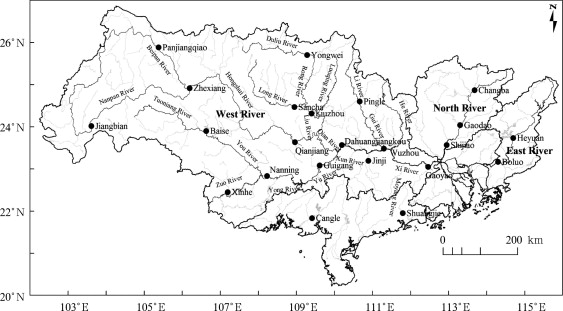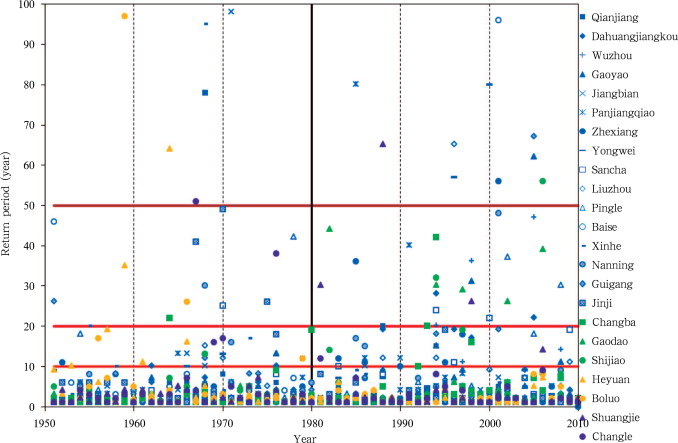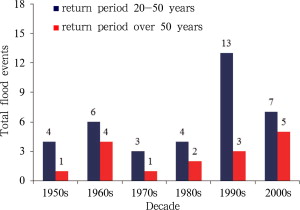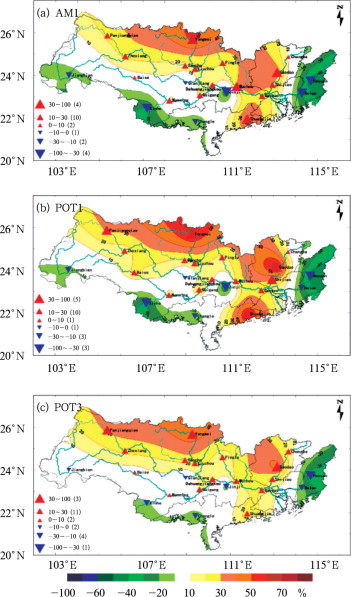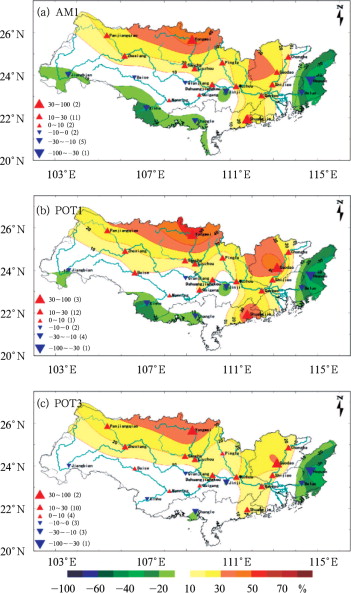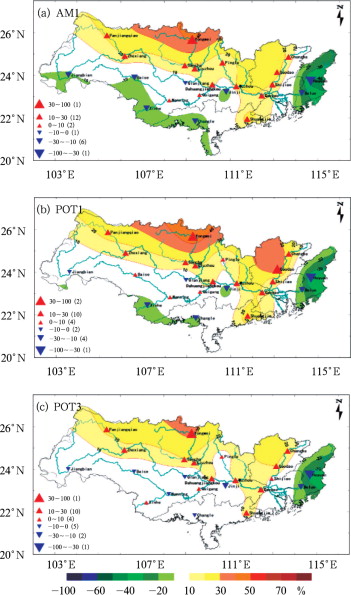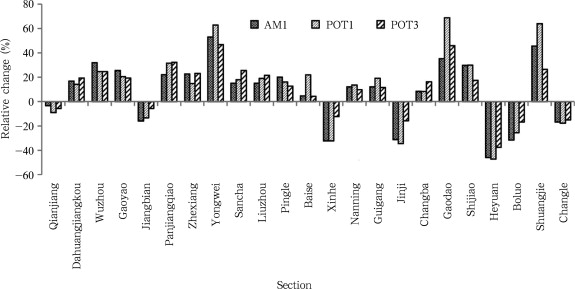Abstract
The study investigated the trend of extreme flood events in the Pearl River basin during 1951–2010. Stream flow data at 23 gauging stations were used for the study. The Pearson type III distribution was selected for the flood frequency analysis. Results indicate that extreme flood events increase significantly in the Pearl River Basin since 1980. At the 23 gauging stations, there are 16 (70%) stations show positive (increasing) trends in 1981–2010. Most of the 16 stations are located along the West River and North River. While 7 (30%) stations show negative (decreasing) trends, and are found in the East River and the southeast region of the West River Basin.
Keywords
flood ; trend ; climate change ; Pearl River Basin
1. Introduction
Global warming in recent decades is unequivocal, as is now evident from observations of increases in global mean surface air temperatures, widespread melting of snow and ice, and rising global sea level [ IPCC, 2007 ]. Observed warming over several decades has been linked to changes in the large-scale hydrological cycle [ Bates et al., 2008 ]. In the last 20 years, floods are becoming more severe or more frequent in China (e.g., Yangtze River flood in 1991, Pearl River flood in 1994 and 1996, Haihe River flood in 1996, Minjiang River flood in 1998, Hanjiang River flood in 2003 and 2005, Huaihe River flood in 2003, 2005 and 2007), which has led to losses of about 1.5% of the gross domestic product (GDP).
The effect of extreme hydro-meteorological events caused by climate change is a public issue. Recently, the IPCC has released a special report [ IPCC, 2012 ], which focused on the relationship between climate change and extreme weather and climate events, the impacts of such events, and the strategies to manage the associated risks. This report provides a careful assessment of the newest scientific, technical, and socioeconomic findings in this field. As there are great uncertainties in predicting precipitation changes in general circulation models, it is still difficult to reasonably evaluate the influence of climate change on extreme precipitation and floods [ Guo, 1995 ; IPCC, 2012 ]. Thus, most of current researches focus on the detection of trends, periods and change in river flow series based on observed data [ Kundzewicz et al ., 2005 ; Cunderlik and Ouarda, 2009 ; Xu et al ., 2009 ]. However, only few studies on trends in flood magnitude and frequency can be found [ Collins, 2009 ]. Therefore, this study is mainly to investigate the trends in the magnitude of extreme flood events using long-term stream flow records in the Pearl River Basin.
2. Data and methodology
2.1. Study region
The Pearl River is the second largest river (in terms of stream flow magnitude) in China with three major tributaries: West River, North River and East River. The Pearl River Basin is located in the tropical and sub-tropical climate zone with annual mean temperatures ranging from 14°C to 22°C and annual mean precipitation ranging from 800 mm to 2,500 mm. Precipitation during April–September accounts for 70%–80% of the annual total amount. Influenced by the southwest monsoon, its geographic location and landform, flood disasters happened frequently in this basin in the past. Since 1990, extreme floods have successively occurred (in the whole basin in June 1994, the Liujiang River in July 1996, and the West River in June 1998 and June 2005) [ She and Xie, 2007 ], which have a seriously negative impact on the regional social and economic development.
2.2. Data
Daily stream flow data at 23 gauge stations in 1951–2010 were obtained from the Information Center of the Ministry of Water Resources. Figure 1 shows the geographic distribution of the 23 stations in the Pearl River Basin. Of all the stations, 16 are located along the West River, 3 along the North River, 2 along the East River, and 2 are found in the eastern region of Guangdong province and the southern region of Guangxi autonomous region. There are 4 stations controlling a catchment area of more than 100,000 km2 , 13 stations covering catchment areas between 10,000 and 100,000 km2 and 6 stations with a catchment area less than 10,000 km2 .
|
|
|
Figure 1. Geographic distribution of the 23 gauging stations in the Pearl River Basin |
Meteorological data are obtained from the daily climate database with 752 basic meteorological stations nationwide from 1951 to 2010, collected from the China Surface Climate Daily Value Set on China Meteorological Data Sharing Service System (http://cdc.cma.gov.cn/index.jsp ). We used the data of 89 meteorological stations located in the Pearl River Basin and nearby to calculate the annual mean temperature and precipitation during 1951–2010. Figure 2 shows that the annual mean temperature has an increasing trend during 1951–2010 and becomes significantly higher after the mid-1980s. For the annual precipitation, no obvious trends are apparent. However, Wang et al. [2006] found that precipitation is unevenly distributed within a year during the recent 40 years covered in their study, which could increase the probability of flood and drought disasters in the Pearl River Basin.
|
|
|
Figure 2. Annual mean temperature (a) and annual precipitation (b) and the linear trend in the Pearl River Basin during 1951–2010 |
2.3. Methodology
According to the manual Standard of Hydrological Information and Hydrological Forecasting (GB/T 22482-2008) officially issued by the Ministry of Water Resources, extreme flood events are defined as at least 10-year flood events. This definition is taken for this study.
The analysis of extreme flood events can be conducted using the annual-maximum (AM) approach and the peaks-over-threshold (POT) approach. Three indices were calculated to describe the characteristics of floods using both approaches. The first index is the annual maximum daily mean stream flow (AM1), i.e., only the maximum daily mean stream flow of each year is retained. We also selected the largest independent flood event per year (POT1) and average three largest events per year (POT3) for 1951–2010, because no generally acknowledged method has been proposed to determine a value of threshold [ Guo, 2005 ]. The peaks in POT series were considered to be independent of each other if they were separated by a particular time interval. Based on the results of other researches [ Svensson et al., 2005 ; Petrow and Merz, 2009 ] and inspection of the time series, the time interval between peaks was set to at least 5 days for catchments with areas no more than 3,000 km2 , at least 10 days for catchments with areas between 3,000 km2 and 45,000 km2 , at least 15 days for catchments with areas between 45,000 km2 and 100,000 km2 , and at least 25 days for catchments greater than 100,000 km2 .
The Pearson type III frequency distribution has been extensively used in China, specifically in the southern region [ Li, 1984 ], and is recommended for calculating the design flood. Moreover, it is easily to be compared with related studies. Therefore, we selected this frequency distribution for flood frequency analysis.
3. Results
3.1. Frequency of flood events
The frequency of extreme flood events is shown in Figure 3 ; Figure 4 . The results indicate that the flood events have significantly increased after the 1980s, in particular for the extreme flood events in the last two decades. For example, floods with return periods 20–50 years have occurred 13 times during 1991–2000 and more than 50-year-flood events have happened 5 times during 2001–2010. These are the highest frequencies of the two return period categories during 1951–2010.
|
|
|
Figure 3. Occurrence of floods at the 23 stations in the Pearl River Basin during 1951–2010 |
|
|
|
Figure 4. Decadal occurrences of extreme flood events in the Pearl River Basin during 1951–2010 |
3.2. Trends in extreme flood events
The Pearl River Basin has experienced a warmer climate since the mid-1980s (Fig. 2 ). In order to better understand changes in flood occurrences, the whole period (1951–2010) was divided into two sub-periods (1951–1980 and 1981–2010). Geographic distributions of the relative changes of extreme flood events based on the 50-, 20-, and 10-year return period in the two periods are shown from Figure 5 , Figure 6 ; Figure 7 .
|
|
|
Figure 5. Geographic distributions of the relative changes (%) of the 50-year flood for (a) AM1 series, (b) POT1 series and (c) POT3 series during 1981–2010 compared with the period 1951–1980 |
|
|
|
Figure 6. Same as Figure 5 , but for the 20-year flood |
|
|
|
Figure 7. Same as Figure 5 but for the 10-year flood |
Among the 23 analyzed stations, 16 (70%) stations show positive (increasing) trends and 7 (30%) stations show negative (decreasing) trends for the 50-year flood based on the AM1 time series. Most stations with positive trends are located along the West River and the North River. The highest increase of the 50-year flood with 53.1% is found for Yongwei station along the West River. The majority of stations with negative trends are found in the southwest part of the West River Basin and the East River Basin. Heyuan station shows the highest decrease of 35.2%. The trends of the 10-year flood and the 20-year flood are similar to the 50-year flood, but the magnitudes are relatively smaller.
4. Discussion
In general, the trends in extreme flood events in the downstream region are consistent with that in the upstream. However, the trend at Nanning station is opposite to the trend at Xinhe station, which is located in the Yong River. There are two main reasons for the inconsistency. Firstly, the drainage area of Xinhe station (5,791 km2 ) is much less than that of Nanning station (72,656 km2 ). Secondly, heavy precipitation often occurs outside the drainage area of Xinhe station. Therefore, the flood events at Xinhe station contribute less to the flood potential at Nanning station.
Figure 8 shows the differences in the AM1, POT1 and POT3 series for 50-year flood events at the 23 stations. The smallest difference in these flood series is 2.7%, which is observed at Changle station, while the largest difference of 37.5% is found at Shuangjie station. In general, the difference decreases with an increase in catchment area. For instance, the difference is below 10% for the stations with a catchment area of more than 100,000 km2 , such as Qianjiang, Dahuangjiangkou, Wuzhou and Gaoyao station.
|
|
|
Figure 8. Relative changes (%) of the 50-year flood for AM1, POT1 and POT3 series in the period 1981–2010 compared with 1951–1980 |
It is easy to measure the influences of extreme precipitation on such extreme flood events, as flood is usually a rainstorm-based event in the Pearl River Basin. Therefore, we calculated the annual maximum consecutive 3-day precipitation. The results show that the change of the extreme precipitation is consistent with that of the extreme flood events. For example, there is an increase of 6.3% in the annual maximum consecutive 3-day precipitation and an increase of the 50-year flood event by 20.2% at Pingle station located in the West River Basin in 1981–2010 compared with those in 1951–1980. In addition, hydraulic engineering
structures might have significant effects on the trends of extreme flood events. In the East River Basin, there are three major reservoirs, the Xinfeng River reservoir, the Fengshuba reservoir and the Baipenzhu reservoir, which control nearly half of the catchment area. Here, the annual maximum consecutive 3-day precipitation decreased by 5.1%, while the 50-year flood magnitude decreased significantly by 45.8%.
5. Conclusions
In general, the frequency of extreme flood events increased significantly in the Pearl River Basin since 1990. During the two sub-periods (1951–1980 and 1981–2010), results show that among the 23 analyzed stations, 16 (70%) show positive (increasing) trends. Most of the 16 stations are located along the West River and North River. Around 7 (30%) stations show negative (decreasing) trends. These are mostly found along the East River and the southeast region of the West River Basin. The trends in extreme flood events in the downstream sections are consistent with that in the upstream sections. For three flood indices, the difference in index values decreases with an increase in catchment area. However, the reasons for the changes in extreme flood events are only briefly discussed in this study, which need to be thoroughly analyzed in the future.
Acknowledgements
This work is supported by National Basic Research Program of China (No. 2010CB428405), Special Public Sector Research Program of Ministry of Water Resources (No. 201301040 and 201301070), National Natural Science Foundation of China (No. 41001012), Foundation for the Author of National Excellent Doctoral Dissertation of China (No. 201161), Qing Lan Project and Program for New Century Excellent Talents in University.
References
- Bates et al., 2008 B.C. Bates, Z.W. Kundzewicz, S. Wu, et al.; Climate change and water; Technical paper of the intergovernmental panel on climate change (2008), p. 37
- Collins, 2009 M.-J. Collins; Evidence for changing flood risk in New England since the late 20th century; Journal of the American Water Resources Association, 45 (2) (2009), pp. 279–290
- Cunderlik and Ouarda, 2009 J.M. Cunderlik, T. Ouarda; Trends in the timing and magnitude of floods in Canada; Journal of Hydrology, 375 (3–4) (2009), pp. 471–480
- Guo, 1995 S.-L. Guo; Impacts of climate change on flood frequencies and peak discharges; Advances in Water-Science (in Chinese), 6 (3) (1995), pp. 224–230
- Guo, 2005 S.-L. Guo; Advances and Assessment on Design Flood (in Chinese) ; China Water & Power Press, 46–48 (2005)
- IPCC, 2007 IPCC; Climate change 2007 synthesis report (2007[2011-12-13]) Accessed http://www.ipcc.ch/publications_and_data/ar4/syr/en/contents.html.
- IPCC, 2012 IPCC; Managing the risks of extreme events and disasters to advance climate change adaptation (2012-03-28[2012-05-08]) Accessed http://ipcc-wg2. gov/SREX/.
- Kundzewicz et al., 2005 Z.W. Kundzewicz, D. Graczyk, T. Maurer, et al.; Trend detection in river flow series: 1. Annual maximum flow; Hydrological Sciences Journal (in France), 50 (5) (2005), pp. 797–810
- Li, 1984 S.-S. Li; Study on the adaptability of some curve types of frequency distribution for the Chinese flood data; Journal of China Hydrology (in Chinese), 1 (1984), pp. 1–7
- Petrow and Merz, 2009 T. Petrow, B. Merz; Trends in flood magnitude, frequency and seasonality in Germany in the period 1951–2002; Journal of Hydrology, 371 (1–4) (2009), pp. 129–141
- She and Xie, 2007 Y.-G. She, H.-X. Xie; New features of Pearl River Basin water regime since 1990s; Pearl River (in Chinese), 4 (2007), pp. 23–25
- Svensson et al., 2005 C. Svensson, W.Z. Kundzewicz, T. Maurer; Trend detection in river flow series: 2. Flood and low-flow index series; Hydrological Sciences Journal (in French), 50 (5) (2005), pp. 811–824
- Wang et al., 2006 Z.-L. Wang, X.-H. Chen, L. Zhang, et al.; Spatial-temporal change characteristics of precipitation in the Pearl River Basin in recent 40 years; Journal of China Hydrology (in Chinese), 26 (6) (2006), p. 7175
- Xu et al., 2009 D.-X. Xu, G.-X. Zhang, X.-R. Yin; Runoff variation and its impacting factor in Nenjiang River during 1956–2006; Advances in Water Science (in Chinese), 20 (3) (2009), pp. 416–421
Document information
Published on 15/05/17
Submitted on 15/05/17
Licence: Other
Share this document
Keywords
claim authorship
Are you one of the authors of this document?
